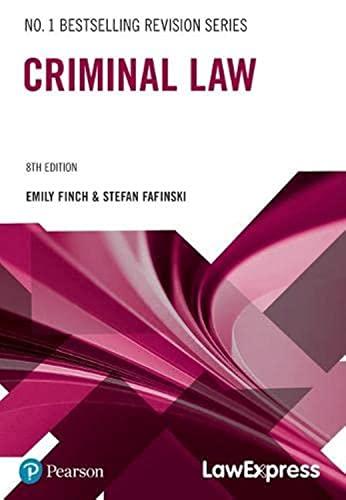Question
Please review key terms at the end of the chapter and answer questions 3, 4, and 14 at the end of chapter 7 in the
Please review key terms at the end of the chapter and answer questions 3, 4, and 14 at the end of chapter 7 in the eText. The assignment is due no later than 11:59 pm ET on Saturday of week 7. Please cite specific eText pages where you found support for your answers.
3. Baker and others entered a Walmart store shortly after 3:00 a.m. by cutting through the metal door with an acetylene torch. They had moved some of the merchandise in the store to the rear door, but the police arrived before the merchandise could be taken from the store. Baker was prosecuted for larceny. He argued that he was not guilty of larceny because no merchandise had ever left the store. Is there enough intent and action for a crime? [Tennessee v. Baker, 751 S.W.2d 154 (Tenn. App.
4. Sergeant Kenneth Riley used videos of a fellow officer, not for training purposes but to get a fellow officer disciplined. He showed the videos to those within the department who would not have the authorization to view them. Riley was indicted for unauthorized use of a computer and unauthorized access and disclosure of computer data. Riley moved to have the indictment dismissed. What should the court do with the case and why? [New Jersey v. Riley, 988 A.2d 1252 (N.J. 2009)]
14. Kathryn Erickson was the general manager of the Uintah Special Services District (USSD), an entity created to use federal-mineral-lease revenues for road projects. She, along with her secretary, Cheryl McCurdy, administered the USSD from a small office in Vernal, Utah. Ms. Erickson's authority was limited and she was not permitted to enter into or modify contracts for or to expend more than $1,000 of USSD funds, without board approval. Mitchell Construction was a major contractor for USSD. In 1998, USSD awarded Mitchell Con-struction a contract to haul gravel from a site called Hamaker Bottoms and another contract to carry out small asphalt-paving projects. Both contracts were to be completed within the 1998 construction year. During 1999 and 2000, Mitchell Construction continued to perform work on the projects covered by its 1998 contracts with USSD, despite their expiration. It submitted invoices to USSD and was paid for this work. In June 1999, a federal grand jury began to investigate contracting irregularities at USSD and the Uintah County Road Department. It issued a subpoena duces tecum to USSD requesting copies of "project contracts, invoices" between USSD and contractors. While the office was preparing the response for the grand jury subpoena, Ms. McCurdy saw Ms. Erickson prepare a handwritten change order for the Hamaker Bottoms contract and saw Ms. Erickson and Gilman N. Mitchell both sign it. The change order, which was backdated to January 13, 1999, extended the contract through December 31, 2000. Ms. McCurdy later discovered that two other change orders had been created and backdated. She spent a day copying documents for the grand jury and recording, on a handwritten list, all of the documents that she had copied. However, she left Ms. Erickson in the office while she was working on the list in order to go home for dinner. Ms. Erickson called her and told her not to come back because all the copying was done. Later, Ms. McCurdy found on Ms. Erickson's desk a photocopy of the grand jury document list and saw that two entries not in her handwriting had been added. These entries were for change orders for contracts between Mitchell Construction and USSD. Ms. McCurdy reported the change to the government. Ms. Erickson and Mr. Mitchell were each in-dicted by a grand jury in the U.S. District Court for the District of Utah on three counts of obstruction of justice by knowingly falsifying a document with the knowledge and intent that the grand jury would rely on it. Are both the elements of mental intent (scienter) and action present for criminal convictions here? [U.S. v. Erickson, 561 F.3d 1150 (10th Cir.)]
Book information;
Anderson's Business Law & The Legal Environment - Comprehensive Edition, 24th Edition
ISBN: 9780357363850
By: David P. Twomey; Marianne M...
Chapter 7
Please use the book to answer the questions.
Step by Step Solution
There are 3 Steps involved in it
Step: 1

Get Instant Access to Expert-Tailored Solutions
See step-by-step solutions with expert insights and AI powered tools for academic success
Step: 2

Step: 3

Ace Your Homework with AI
Get the answers you need in no time with our AI-driven, step-by-step assistance
Get Started


